How to Introduce Yoga to Your Dog: A Beginner's Guide
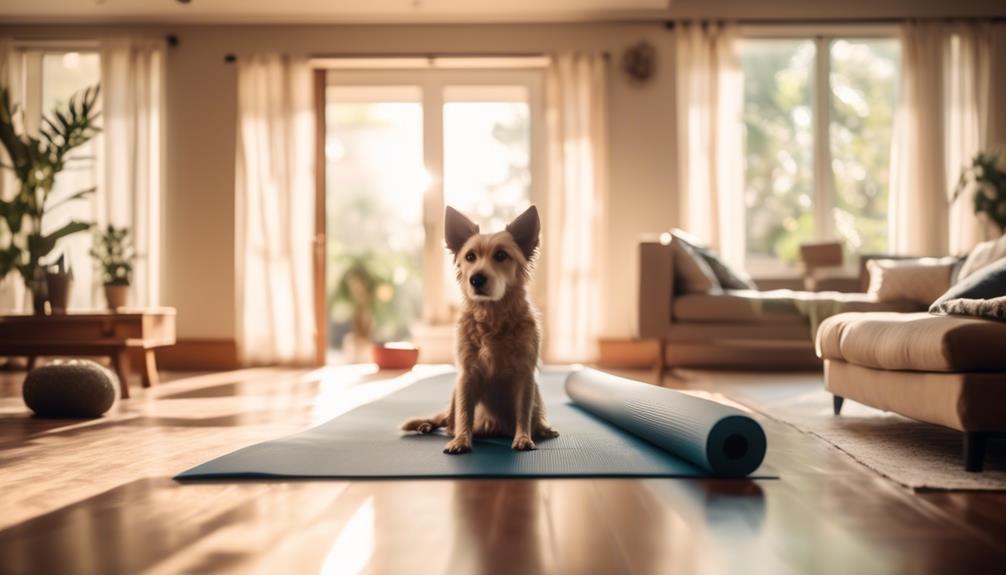
Introducing yoga to your dog can bring increased flexibility, strength, and a deeper bond between you and your furry friend.
Learn how to make downward dog a family affair with this beginner's guide.
Key Takeaways
- Practicing yoga with your dog can strengthen the bond between you and your pet, increase trust, and improve communication.
- Preparing your dog for yoga sessions involves ensuring understanding of basic obedience commands, reinforcing these commands, introducing relaxation techniques, and creating a peaceful environment.
- Essential yoga poses for dogs include Downward-Facing Dog, Puppy Pose, Upward-Facing Dog, and Seated Twist, and using dog-friendly yoga accessories can enhance the practice.
- Dog yoga offers benefits such as improved flexibility and joint health, calming hyperactive dogs, improving focus and concentration, and strengthening the bond between you and your dog, while also alleviating stress and anxiety.
Benefits of Practicing Yoga With Your Dog
Practicing yoga with your dog offers a multitude of benefits for both you and your furry companion. Canine yoga, also known as doga, is a wonderful way to bond with your pet while improving your own physical and mental well-being.
One of the key benefits of practicing yoga with your dog is the strengthening of your bond. Through coordinated movements and shared experiences, you and your pet develop a deeper connection and understanding of each other. This can lead to increased trust, improved communication, and a stronger overall relationship.
Additionally, canine yoga provides numerous health benefits for both you and your dog. For you, it helps to reduce stress, improve flexibility and balance, and increase mindfulness. For your dog, it can help to alleviate anxiety, improve joint health, and enhance overall physical fitness.
Introducing yoga to your pet may take some time and patience, but the rewards are well worth the effort. Start with simple poses and gradually progress to more advanced ones as your dog becomes more comfortable. Always ensure that the practice is safe and enjoyable for both of you.
Preparing Your Dog for Yoga Sessions
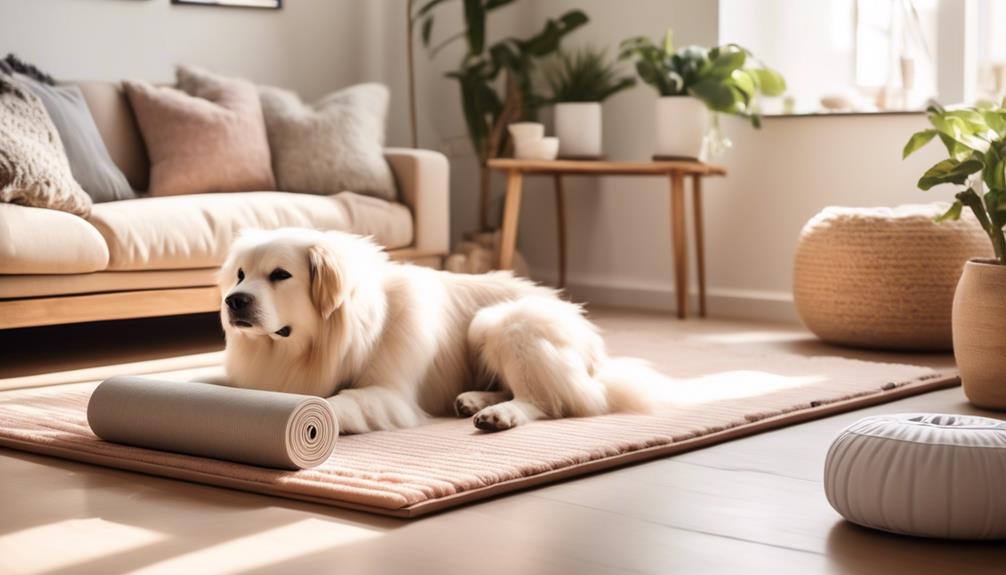
Before you begin practicing yoga with your dog, it is important to properly prepare your furry friend for the sessions. This involves a combination of dog training and relaxation techniques to help them feel comfortable and calm during the yoga practice.
One essential aspect of preparing your dog for yoga sessions is ensuring they have a good understanding of basic obedience commands. This will make it easier for you to direct their movements and keep them focused during the practice. Spending some time each day reinforcing commands such as "sit," "stay," and "down" will help establish a strong foundation for your yoga sessions.
In addition to obedience training, it is also beneficial to introduce relaxation techniques to your dog. This can be done through activities such as massage, gentle brushing, or playing calming music. Teaching your dog to relax and unwind will help create a peaceful environment for both of you to enjoy the yoga practice together.
To assist you in preparing your dog for yoga sessions, here are some useful techniques:
| Dog Training | Relaxation Techniques |
|---|---|
| Obedience commands | Massage |
| Focus exercises | Gentle brushing |
| Leash training | Calming music |
Essential Yoga Poses for Dogs
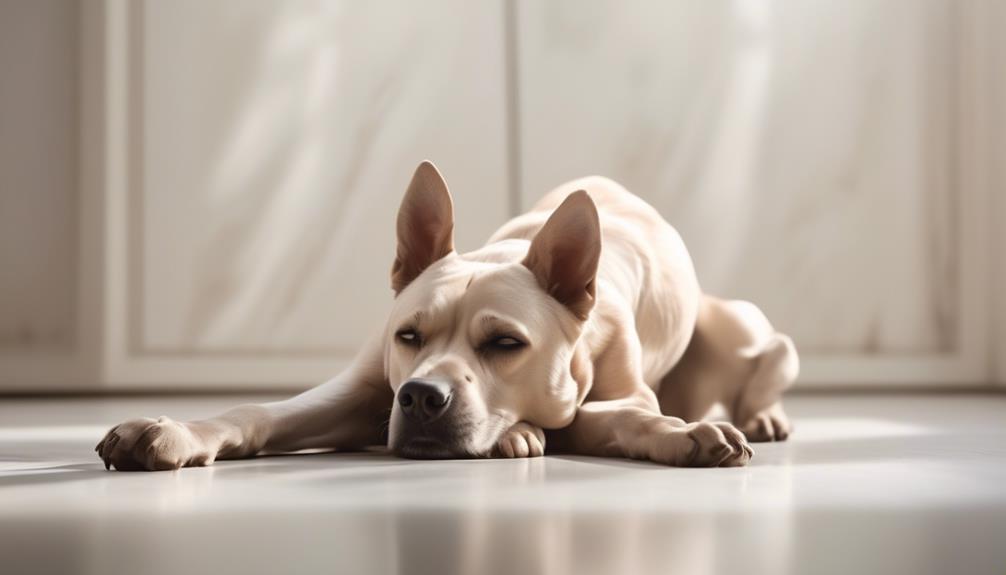
When it comes to introducing yoga to your dog, there are several essential poses to consider. These dog-friendly yoga poses not only help improve flexibility and strength, but they also provide mental stimulation and relaxation for your furry friend.
In addition to the physical benefits, practicing yoga with your dog can also strengthen the bond between you and promote a sense of calm and well-being.
Dog-Friendly Yoga Poses
To ensure a safe and enjoyable experience, incorporating dog-friendly yoga poses is essential when introducing your four-legged friend to the practice. Dogs have different physical abilities and limitations compared to humans, so it's important to choose poses that are suitable for them.
Here are some dog-friendly yoga poses to get you started:
- Downward-Facing Dog: This pose stretches the spine and strengthens the legs. It also helps to calm and relax your dog.
- Puppy Pose: Similar to Child's Pose, this pose gently stretches the back and shoulders. It can be soothing for dogs and helps to release tension.
- Upward-Facing Dog: This pose opens the chest and strengthens the back and arms. It can be energizing and invigorating for your dog.
- Seated Twist: This pose improves digestion and releases tension in the spine. It can be beneficial for dogs with gastrointestinal issues.
Remember to always use dog-friendly yoga accessories, such as a non-slip mat, to ensure your dog's safety during the practice. Additionally, the best time of day to practice dog yoga is when your dog is relaxed and not too energetic, like after a walk or playtime.
Benefits of Dog Yoga
Dog yoga, also known as 'doga,' offers numerous benefits for both dogs and their owners. Canine yoga not only promotes physical well-being but also helps with mental and emotional relaxation. Dogs, just like humans, can experience stress and anxiety, and doggy relaxation techniques can help alleviate these issues.
One of the main benefits of dog yoga is improved flexibility and joint health. The gentle stretches and movements in canine yoga help keep the muscles and joints supple and reduce the risk of injury. Additionally, dog yoga can help calm hyperactive dogs and reduce their energy levels. It can also improve their focus and concentration.
Moreover, practicing yoga with your dog can strengthen the bond between you and your furry friend, creating a deeper sense of trust and connection.
Safety Tips for Dog Yoga
As you embark on the journey of practicing dog yoga, it's crucial to prioritize the safety and well-being of both you and your furry companion. Here are some essential safety tips to keep in mind:
- Use appropriate dog yoga equipment: Invest in a good quality yoga mat designed specifically for dogs to provide them with a comfortable and secure surface to practice on. Additionally, consider using props like blankets or bolsters to support their bodies in certain poses.
- Start slow and gradually increase intensity: Just like humans, dogs need time to build their strength and flexibility. Begin with simple poses and gradually introduce more challenging ones to prevent injuries.
- Watch for signs of discomfort: Pay close attention to your dog's body language during the practice. If they show signs of distress, such as panting excessively or trying to escape the pose, gently release them from it and move on to something more comfortable.
- Avoid common injuries in dog yoga: Some common injuries in dog yoga include strains, sprains, and muscle pulls. To prevent these, always warm up your dog before the practice and ensure proper alignment in each pose.
Incorporating Mindfulness Techniques in Your Dog's Yoga Practice
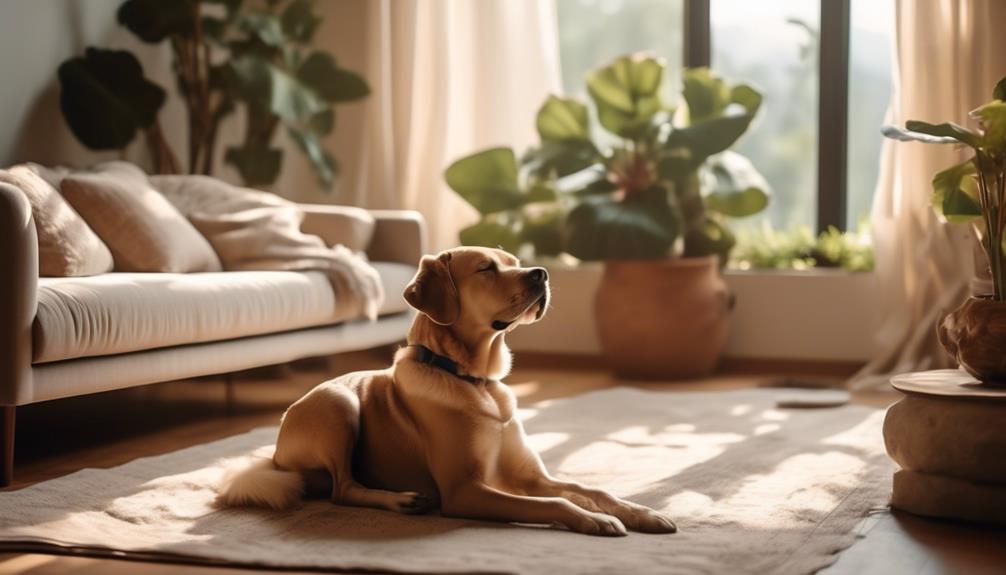
By incorporating mindfulness techniques, dog owners can enhance their canine companions' yoga practice, promoting relaxation, focus, and a deeper mind-body connection. Mindfulness exercises and calming techniques can help dogs find inner peace and improve their overall well-being. Just like humans, dogs can benefit from being present in the moment and cultivating a sense of awareness.
One effective mindfulness exercise for dogs is deep breathing. Encourage your dog to take slow, deep breaths while you guide them through the practice. This can help them relax and release any tension or anxiety they may be experiencing. Another technique is body scanning, where you gently touch or stroke different parts of your dog's body, helping them to focus their attention on each area. This exercise can be especially helpful for dogs who are hyperactive or easily distracted.
To evoke a sense of calmness and tranquility in your dog's yoga practice, try incorporating the following techniques:
| Technique | Description | Benefits |
|---|---|---|
| Visualization | Guide your dog through visualizing a peaceful and serene environment. | Reduces stress and anxiety, promotes relaxation |
| Affirmations | Repeat positive affirmations to your dog, such as "You are loved and safe." | Boosts self-confidence and sense of security |
| Gentle Touch | Use gentle touch to connect with your dog and create a soothing sensation. | Enhances the bond between you and your dog, promotes relaxation |
Incorporating mindfulness techniques in your dog's yoga practice can be a transformative experience for both you and your furry friend. It allows you to deepen your connection and create a harmonious atmosphere that promotes relaxation and well-being. Remember to be patient and compassionate throughout the process, as each dog may respond differently to these techniques.
Tips for Creating a Peaceful Yoga Environment for Your Dog
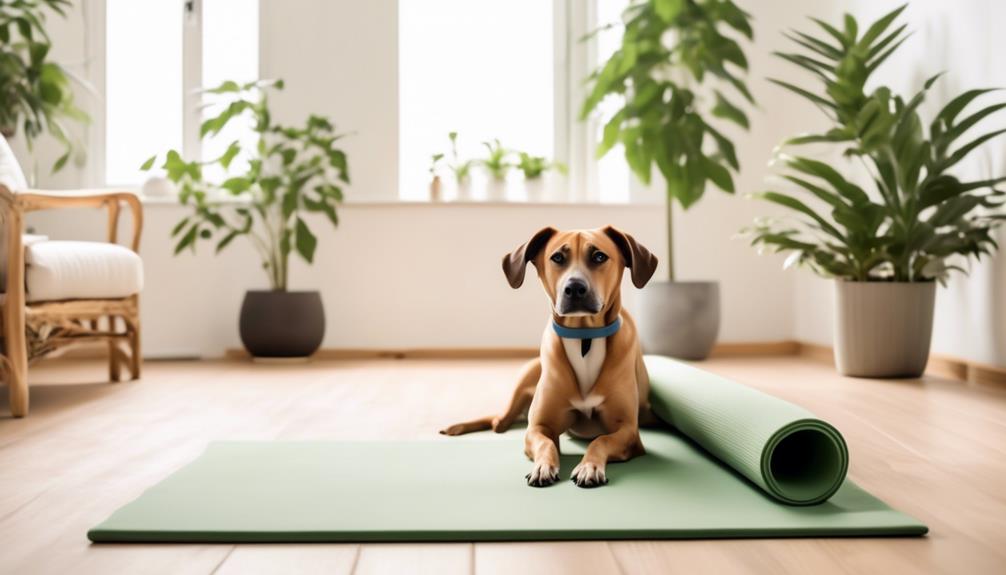
To create a tranquil and harmonious environment for your dog's yoga practice, it's essential to set the stage with careful attention to detail. Creating a relaxing atmosphere and using calming techniques for dogs during yoga sessions can greatly enhance their experience. Here are some tips to help you create the perfect environment for your furry friend:
- Choose a quiet and peaceful location: Find a quiet space in your home where your dog feels safe and comfortable. Make sure the area is free from distractions, such as loud noises or other pets.
- Use calming scents: Certain scents, like lavender or chamomile, can help create a calming atmosphere. Consider using essential oils or scented candles to create a soothing environment for your dog.
- Soft lighting: Dim the lights or use soft, natural lighting to create a calming ambiance. Harsh or bright lights can be overwhelming for dogs during their yoga practice.
- Play soothing music: Gentle, instrumental music can help relax your dog during yoga sessions. Choose soft melodies or nature sounds to create a peaceful atmosphere.
Building a Consistent Yoga Routine With Your Dog

Establishing a consistent yoga routine with your dog is key to their growth and progress in the practice. Just like humans, dogs benefit from regular practice to improve their flexibility, strength, and overall well-being. To build a consistent yoga routine with your furry friend, it's important to create a sense of structure and familiarity.
Set aside specific times each day for your yoga sessions, ensuring that they fit well into your dog's daily routine. Consistency will help your dog understand that yoga is a regular activity and allow them to fully embrace it.
In addition to consistency, building a yoga community can also be beneficial for both you and your dog. Joining a local dog yoga class or organizing yoga sessions with other dog owners can provide a supportive environment where both you and your dog can learn and grow together. This sense of community can also help in motivating you to stick to your yoga routine.
When practicing yoga with your dog, it's important to remember the importance of playfulness. Incorporating play and fun into your sessions won't only make it enjoyable for your dog, but it will also strengthen the bond between you.
Use toys, treats, and positive reinforcement to encourage your dog to participate in the practice. By making the sessions playful and engaging, your dog will look forward to their yoga time and eagerly cooperate.
Advanced Yoga Techniques to Try With Your Dog
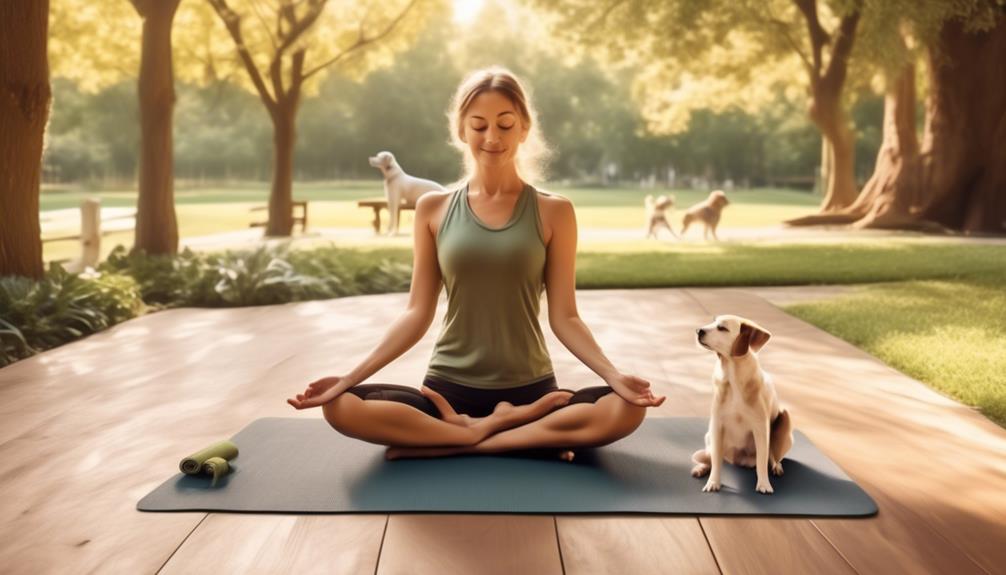
To take your yoga practice with your dog to the next level, explore these advanced yoga techniques that will challenge both you and your furry companion. These advanced dog poses are designed to test your strength, balance, and flexibility while also keeping your dog engaged and active.
Here are some tips for challenging your dog in yoga:
- Downward Dog with a Twist: Begin in a traditional downward dog pose and then slowly rotate your torso to one side, reaching your opposite hand towards your dog. Encourage your dog to mirror your twist by turning their body in the same direction. This pose not only stretches your spine but also engages your dog's core muscles.
- Partner Plank: Get into a plank position with your dog sitting between your hands. As you hold the plank, gently encourage your dog to place their front paws on your back, creating a partner plank. This pose challenges your core stability and strengthens your dog's front legs.
- Warrior III with Doggy Dancer: In the warrior III pose, extend one leg back and hinge forward from the hips, while lifting the opposite leg and extending it backward. As you balance, encourage your dog to stand on their hind legs and reach their front paws towards you. This pose improves your balance and coordination while also working your dog's hind legs.
- Double Doga: Lie on your back with your feet raised and knees bent, creating a tabletop position. Lift your dog and gently place them on your shins, encouraging them to balance on your legs. This pose challenges your core strength while also allowing your dog to engage their balancing skills.
Remember to take it slow and be mindful of your dog's comfort and abilities. With patience and practice, these advanced yoga techniques will deepen the bond between you and your furry friend while keeping both of you fit and healthy.
Frequently Asked Questions
Can I Practice Yoga With My Dog if They Have a Physical Injury or Condition?
When practicing yoga with a dog who has a physical injury or condition, it's important to take precautions and make modifications to ensure their safety. Consult a veterinarian and a yoga instructor for guidance.
How Often Should I Practice Yoga With My Dog?
It's important to consider the frequency of practicing yoga with your dog. Regularity is key, but start slow and gradually increase the sessions. Listen to your dog's cues and abilities, ensuring their comfort and enjoyment.
Is It Safe to Practice Yoga With My Dog if They Are Pregnant or Nursing?
Practicing yoga with a pregnant or nursing dog can be unsafe. It is important to consult with a veterinarian before incorporating yoga into their routine. Their health and well-being should always come first.
Can I Practice Yoga With My Dog if They Are Older or Have Limited Mobility?
Practicing yoga with older dogs or those with limited mobility requires adapting poses to accommodate their needs. It's a wonderful way to help them maintain flexibility and promote overall well-being.
Are There Any Specific Yoga Props or Accessories That I Should Use When Practicing With My Dog?
When practicing yoga with your dog, there are several yoga props for dogs that can enhance your practice. These props can help support your dog's alignment, balance, and flexibility, ensuring a safe and beneficial experience for both of you. The benefits of practicing yoga with your dog include increased bonding, relaxation, and overall well-being.









